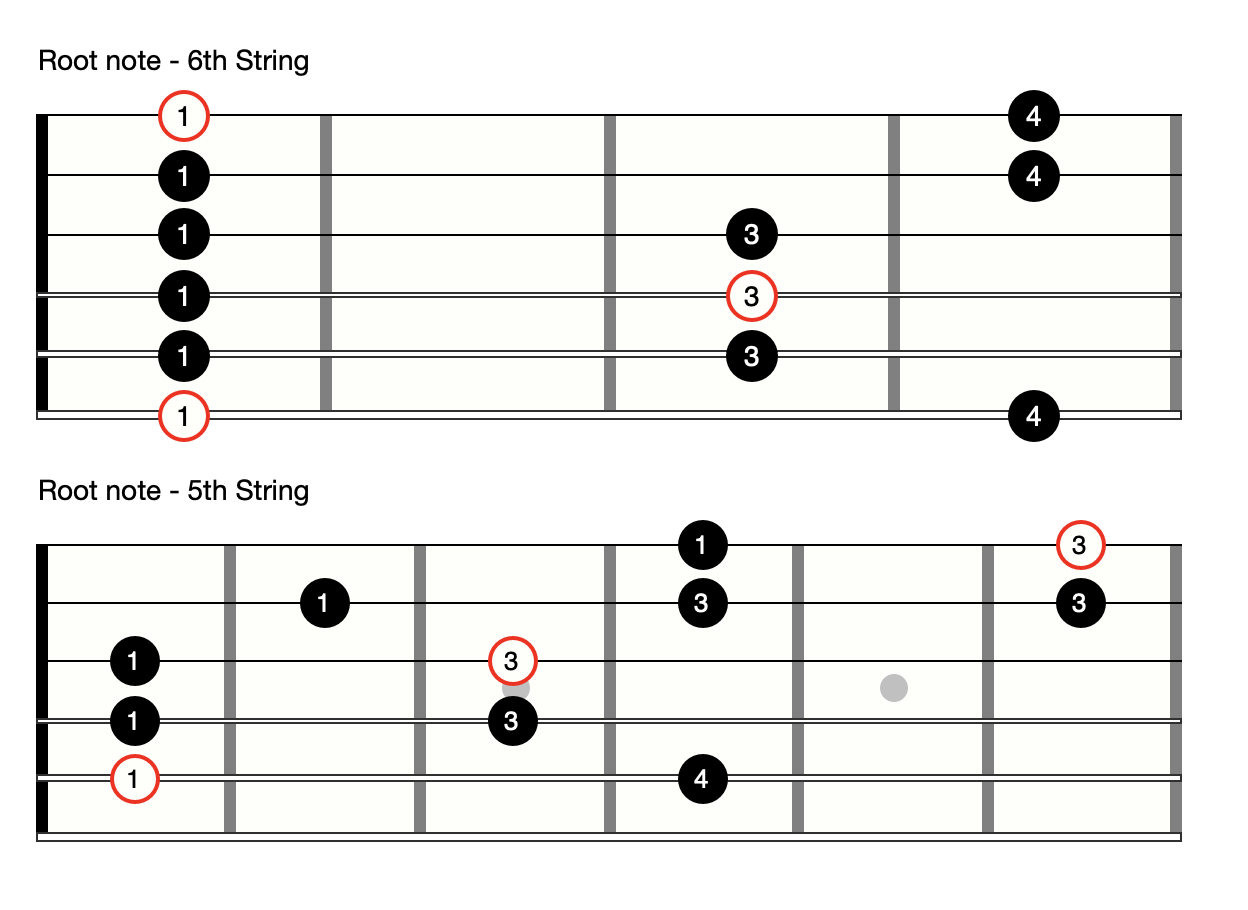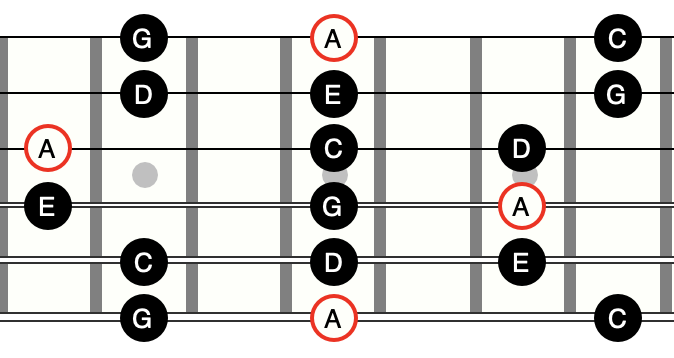The first scale most guitarists learn is the minor pentatonic scale.
It’s versatile, it’s easy and is used in a good 90% of the memorable guitar solos we know and love.
Eventually, you’ll probably feel it’s a bit limiting in isolation. So where should you go next?
One often overlooked alternative is the major pentatonic - a scale which is not as different as you might think.
Recap: What is the Minor Pentatonic Scale?
In musical terms, the minor pentatonic scale is made up of 5 notes. We often refer to these notes as:
1 - b3 - 4 - 5 -b7
which is really just comparing it to the notes of a major scale.
For example, a C Major Scale is made up of C - D - E - F - G - A - B. We count C as 1, D as 2, E as 3 and so on.
So, using that knowledge, a C Minor Pentatonic Scale is made up of the notes:
C - Eb - F - G - Bb
All of these notes also appear in the C Natural Minor Scale, so you could also think of it as a cut down Natural Minor Scale if you’d prefer.
Root notes marked with red circles.
For more info on Minor Pentatonic, check out:
The only 3 scales you absolutely need to master on the guitar (hint: Minor Pentatonic is one of the 3, and Major Pentatonic is not, but I’ll explain why that is shortly)
Why bother learning any new scales if Minor Pentatonic is the most popular?
The only reason to learn new scales is to either:
broaden your options
give you new ways to play the same notes, which will encourage new creative ways of putting notes together
So, if you’re already happy with the minor pentatonic and feel no need to broaden your sound with more options or feel like you have enough creative options already, then the rest of this article is not for you!
If, however, you want more, read on.
What’s the Major Pentatonic Scale?
If you’re familiar with relative minors and majors, the major pentatonic scale is just a relative minor pentatonic scale.
In other words, it also has 5 notes, which would be:
1 - 2 - 3 - 5 - 6
So a C Major Pentatonic scale would be
C - D - E - G - A
Note that they’re not the same numbers, or scale degrees as the minor pentatonic scale, which means you’ll have gaps in different places to the minor pentatonic.
Root notes marked with red circles.
It’s arguably a little harder to play than the minor pentatonic scale, but not by much.
Now, in regards to relative majors and minors, the notes for A minor pentatonic are:
A - C - D - E - G
If you compare that to our C Major Pentatonic scale, you’ll see they’re the same notes, just in a different order. C Major Pentatonic and A Minor Pentatonic are relative scales - the same thing played in a different context.
In practical terms, that means the two scales are interchangeable, so with a bit of music theory knowledge, you can make a Major Pentatonic shape sound like a Minor Pentatonic Shape and vice versa. We’ll talk more about that in a minute.
When to use the Minor Pentatonic scale
The minor pentatonic scale sounds great over songs in a minor key. For example, if the song is in A minor, the A minor pentatonic scale will work really well.
Similarly, any time you’re play over a minor chord, the parallel minor pentatonic scale will work nicely. For example, if the chords progression is Dm - Em - Am, I could match the chords by soloing with a D minor Pentatonic, E Minor Pentatonic and A Minor Pentatonic scale.
That’s the basic use cases, but you can get some other cool effects by playing the minor pentatonic over chords other than straight minor chords, so take this more as a starting point rather than a rule.
When to use the Major Pentatonic scale
Take everything I said above and swap it for major chords. Easy.
How to move between both Minor Pentatonic and Major Pentatonic Scales
There’s two approaches I’d recommend to begin with.
The first is to take a song in either C Major or A Minor and use both the C Major Pentatonic and A minor Pentatonic to solo over the song.
In effect, you’re really just using one scale, because both scales only have A - C - D - E - G in them, but this is a great way to give you different ways to play the same notes for more creative options.
Here’s an example of a shape that combines the Root 5 Major Pentatonic with the Root 6 Minor Pentatonic:
The left half is the C Major Pentatonic shape and the right half is the A Minor Pentatonic shape. Note that the root notes would be either A or C, depending on whether you’re playing in a song in the key of C Major or A Minor.
Alternatively, you could move between parallel Major and Minor pentatonic shapes, which is great for blues, for example.
Let’s say you’re doing a solo over a blues in A. You would play the A Minor Pentatonic Scale at times, then move to A Major pentatonic at other times to mix it up.
It takes practice to make it work, as you may hit some clashing notes depending on the chord you’re playing over, but this can really open up your creative options, as you’d now have the notes from A Minor Pentatonic:
A - C - D - E - G
plus the notes from A Major Pentatonic
A - B - C# - E - F#
in your arsenal.
In practice, I tend to only use Major Pentatonic for the occasional bit of extra colour rather than considering it a go to scale for every solo, but used in the right way it can really bring an extra dimension to your solos and melodies that really take it to the next level.
Give it a crack and feel free to share the results!




